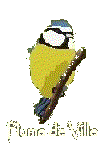Plume de Ville
From day to day.
°°°°°°°°°°°°°°°°°°°°°°° °
January 13
Thawing,
6°C,
rain. There is no more snow, despite this still fresh new banner!
A
morning,
all in red. It has been a long time since I saw a red dawn that tainted
all
with a pretty salmon colour.
8h40
During
the
cold spell I used to break the ice once in a while.
They are happy to find a normal trough, they all want to bath and there
is a
rush to the bath today.
The freeze has irretrievably broken their favourite pool; they must
settle for
the dish this time. But it seems to their liking.
14 January
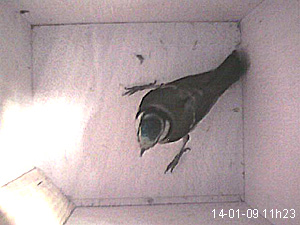
Grey
weather, but warmer. 6 °C.
A short visit today at 11h23.
15 January
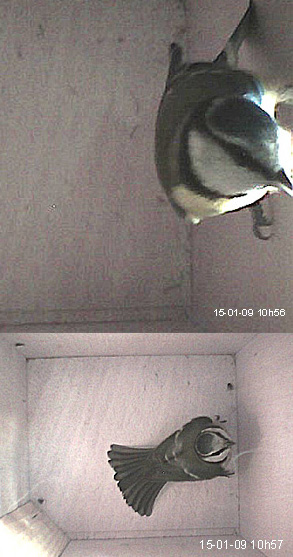
Beautiful blue sky, 6°C,
which inspires much the tit this morning.
Two entries in the nestbox, singing. It stays just a few seconds and
spends a
lot of time at the door.
Some "fans" again and it's gone.
The lighting is natural light in the nest box, quite low, the colours
are not
very bright.
Entries:
December 23 at 11am
January 2 at 11am
January 8 to 10:45 am
January 10 at 10:39 am
January 11 at 11:30 am
January 15 at 10:56 am and
10:57 am
On average 30 to 50 seconds of inspection.
Except for the brawl of January 2 (I do not like to see them fight I am
a bit
reluctant to show them to you), other visits are quiet inspection
visits of the
nest, probably from the male.
The camera is now online. WEBCAM
link. Attention: this year JavaScript is
required. Lighting is natural for the moment and I will switch to IR in
the
evening or if the light is too low. As you can see, the passages are
made in
the morning when the sun lights up the nest
Sorry, not yet translated. Translation in progress.
16 January
Grey, very grey,
not many birds, a short visit at the entrance this morning, the blue
that's
all.
Here is the
new nest box that we installed in early November. I had decided not to
talk
about it until the first entries into the nest box.
It
is time.
We
installed a camera and not a webcam.
Because
of the longer lens focal length, the nest box has grown in order to see
the entire bottom of it.
The
camera is a colour camera and IR, with motion detection.
It is a surveillance IP camera. Relatively small size, which we liked.
After
some research, we settled for a wired camera instead a wifi. Anyway,
even
for a wifi we would have to lay the power cable.
Now we don't have anymore the distance limitations of USB cables. We were, in previous years, well beyond the theoretical limit of usb cables, with the problems that might arise.
The cables
that come down on the left are hidden by a wooden board as the year
before.
These cables had caused much concern to the previous tenants at the
beginning
of nesting, and also to us because they were systematically
pulled and pecked.
The camera
is mounted over a glass plate pierced by a hole for the mike. As
always, the
orientation of the camera can be adjusted from the outside.
The white LEDs provide illumination. It is adjustable from home (ours).
For the moment the camera is not yet streaming and broadcasts, as the
previous
year, the shooting captured by the motion detection.
Less discreet because of its height, the nest box is installed in the same place as the other years.
Cables enter at the bottom rear of the nest box and connectors are housed in a plastic box that protects them from the weather.
30 January
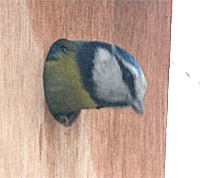
After a short break and grey
days, it's cold again, with a beautiful sun.
Few visits to the nest box. Two visits on 17 and 23 January.
Passage of a long-tailed tit. This is a first on the balcony.
She did not stay
long. The blue tit charged on her and she did not insist and flew,
followed by
the blue. Pity. Curious attitude of the blue tit.
The kestrel
came back twice on the same day. Of course all the birds hid
immediately as
usual. But it seems to come here only for observation, not for hunting.
She comes and asks softly, looking right and left.
She posed quietly on the rail for two long minutes.
Attention, it pricks!
Clearly, dangerous thorns are not a hindrance to it yellow talons.
Perched on the Opuntia, it shows its mottled chest.
The
picture is not good, but it is the only front view that I have.
It
is a
female. I can not say if it is the same, of course.
I wonder if it remains in the area. The kestrels are solitary outside
the
breeding seasons.
Breeding occurs in April and flights in June. If it settles not too far
we
may have the opportunity to see them again. (Well, I still prefer to
remain just
a simple observation post ...).
A hairy dipteran
...
I
found the
photo funny with this reflection.
It is a Syrphe which walked within on the glass.
Out of curiosity, wondering what he was doing there in the winter, I
went
looking for him to try to identify it.
I think it is Heringia Hering. Male.
Size: 1cm
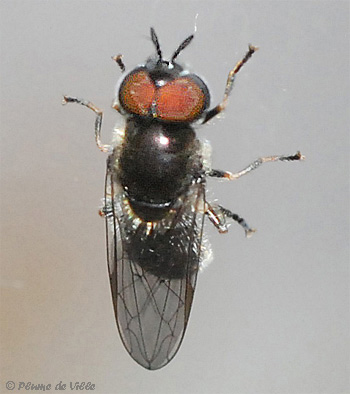
And,
little
surprise, if the identification is correct (whet follows seems to
confirm), new
news of my gall aphids (Pemphigus spirothecae) of the poplar gall spiral.
This time, predator side.
Larvae of this Syrphid parasitize poplar galls and feed on aphids. En
it is these
adults that emerge. It is the larvae which, carnivores, are predators
of
aphids. Adults consume nectar and pollen ... two reasons to welcome
adults and
offspring in the garden!
http://pagesperso-orange.fr/cyrille.dussaix/Heringia_heringi/H.heringi_terrain.html
http://www.galerie-insecte.org/galerie/heringia_heringi.html
http://aramel.free.fr/INSECTES15terterter'-1.shtml
